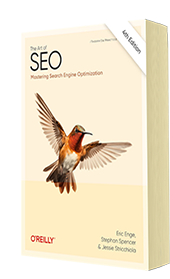SEO: Heads or (Long) Tails?
Search engine optimizing for the “Long Tail” is fundamentally different from optimizing for the head. Therefore, it’s important to initially point out that the strategies and tactics for “Long Tail”SEO are more automated and extensible than for traditional SEO.
For those unfamiliar with the concept of the,Long Tail, it refers to the extremely long right-hand portion of the distribution graph, usually of an online retailer’s product inventory. The term was coined by the Executive Editor of Wired Magazine, Chris Anderson. In comparison, the head occupies very little of the X-axis but is full of the,top hits, and best sellers. Put another way, the head represents the,vital few, and the tail represents the “trivial many.” Anderson argued that the tail could actually add up to as much business as the head for an online retailer with unlimited virtual shelf space and therefore seemingly infinite selection, as is the case for Amazon.com and Netflix.
There are “Long Tail”distribution graphs when it comes to SEO too. Consider the distribution of a keyword portfolio or the distribution of search-delivered traffic among indexed pages of a website. A handful of your search terms are your vital few, driving much of your business, in terms of paid and organic search. A handful of your web pages pull in most of your search visitors. For an online retailer, I purport that the “Long Tail”is where the growth potential in search lies, due to less competition and higher conversion rates. In other words, it will be easier to rank for an esoteric search term containing a model number or a string of keywords, and the visitor brought in through such a query is more likely to turn into a sale.
Typically, there are the several “trophy terms” that the CEO always checks first in the morning. Assuming those search terms are popular with search engine users too, which is not always a given, then these represents part of the “head.” If your rankings drop for a trophy term, I bet you’ll hear about that — probably from the CEO himself/herself. The thing is, trophy term watchers aren’t seeing the big picture. Sure, the head is important, don’t get me wrong. But the tail is just as important, in fact perhaps more so.
Let’s contrast optimizing for the head with optimizing for the “Long Tail.” When optimizing for the head, the home page and secondary level pages represent your best opportunity, because those are the pages most highly endowed with link juice (PageRank). Therefore, you’d focus your energies on optimizing these top-level pages first, targeting no more than three keyword themes per page. The more popular the head keywords are with searchers, the better. You’d place the targeted search term in the title tag, in the H1 tag, and high up in the body copy. You’d further reinforce that page’s PageRank by building inbound links direct to that page and through your internal linking structure. With the internal links, you’d want to consistently incorporate the targeted keywords into the anchor text. With the inbound links, you would not always want the same anchor text, as that doesn’t look natural.
But what should you do to capture the “Long Tail”of SEO? That requires a different plan of attack.
You’ll need to cast a much wider net. Individually optimizing thousands of pages by hand doesn’t make sense; it just won’t scale. Instead, channel your energy into optimizing your HTML templates, your URLs and your internal linking structure because your efforts there are capable of creating cascading effects throughout your website.
Focus on unbranded keywords, as those offer much greater growth potential.
Treat your consumers as content co-creators, populating product reviews, discussion forums, blogs, wikis, and so on with content, thus incorporating your consumers’ vocabulary into your site.
Employ a “Long Tail”SEO approach that we at Netconcepts call “thin slicing.” It involves touching key elements such as title tags and heading tags across thousands of pages quickly, monitoring for impact, and refining based on those results.
Incorporate tag clouds in your site to flatten your internal linking structure and interject keyword-rich text links.
Syndicate your site content (and links) via RSS feeds, as the “Long Tail”is determined in part by the efficient distribution of pages.
And finally, identify your “freeloaders”, the pages in your site that drive no search traffic. Most e-commerce sites are comprised mainly (e.g. 80 plus percent) of “freeloader” pages. Most merchants don’t even know this, or recognize it to be a problem. No JavaScript-based analytics package will tell you this either. It’s an indication you lack a “Long Tail”of unbranded keyword traffic.

Chapter 6:
Keyword Research
From the fundamentals of link building to the nuances of natural linking patterns, virality, and authority.
Related Posts

Embrace Journaling, Tackle Tardiness, and Explore Our Energetic Echo
Here’s what I found inspirational, challenging, or just downright hilarious this week. What caught your eye? And, remember to check out this week’s great podcast episodes: Scaling a SaaS Company with Jason Morehouse “A crucial factor to business success is to find and take the personal path that works best for you.” — Jason Morehouse […]
Read More
Harrison’s harmony, conquering a blank canvas, & gut health hacks
Here’s what I found inspirational, challenging, or just downright hilarious this week. What caught your eye? And, remember to check out this week’s great podcast episodes: Be a Sales Game Changer with Fred Diamond “True elite sales professionals develop a dedicated mindset, proactive client interaction, and continuous self-preparation. They understand their client’s needs and enable […]
Read More
Rebirth of sleeper trains, 4,000 weeks is a long/short time, and golden age for medicine
Here’s what I found inspirational, challenging, or just downright hilarious this week. What caught your eye? And, remember to check out this week’s great podcast episodes: A Story Worth Retelling with Luke Storey “Aligned values are the cornerstone of successful partnerships, whether in business or life, as they shape our moral code, define our priorities, […]
Read More
